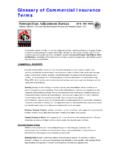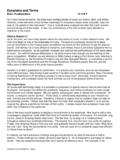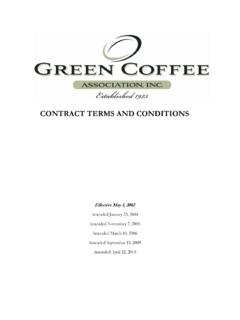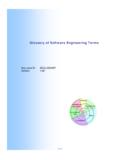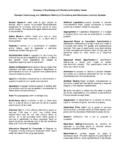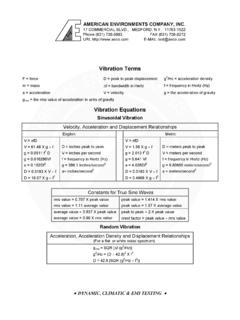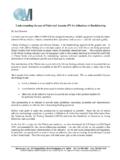Transcription of GLOSSARY OF OILFIELD TERMS
1 GLOSSARY OF OILFIELD TERMS Drilling Operations Abnormal pressure A subsurface condition in which the pore pressure of a geologic formation exceeds or is less than the expected, or normal, formation pressure. When impermeable rocks such as shales are compacted rapidly, their pore fluids cannot always escape and must then support the total overlying rock column, leading to abnormally high formation pressures. Excess pressure, called overpressure or geopressure, can cause a well to blow out or become uncontrollable during drilling. Severe underpressure can cause the drillpipe to stick to the underpressured formation. Air drilling A drilling technique whereby gases (typically compressed air or nitrogen) are used to cool the drill bit and lift cuttings out of the wellbore, instead of the more conventional use of liquids.
2 The advantages of air drilling are that it is usually much faster than drilling with liquids and it may eliminate lost circulation problems. The disadvantages are the inability to control the influx of formation fluids into the wellbore and the destabilization of the borehole wall in the absence of the wellbore pressure typically provided by liquids. Annular pressure Fluid pressure in the annulus between tubing and casing or between two strings of casing. Annular velocity The speed at which drilling fluid or cement moves in the annulus. It is important to monitor annular velocity to ensure that the hole is being properly cleaned of cuttings, cavings and other debris while avoiding erosion of the borehole wall.
3 The annular velocity is commonly expressed in units of feet per minute or, less commonly, meters per minute. The term is distinct from volumetric flow. Annulus The space between two concentric objects, such as between the wellbore and casing or between casing and tubing, where fluid can flow. Pipe may consist of drill collars, drillpipe, casing or tubing. API American Petroleum Institute A trade association founded in 1919 with offices in Washington, DC, USA. The API is sponsored by the oil and gas industry and is recognized worldwide. Among its long-term endeavors is the development of standardized testing procedures for drilling equipment, drilling fluids and cements, called API Recommended Practices ("RPs").
4 The API licenses the use of its monogram (logo), monitors supplier quality assurance methods and sets minimum standards for materials used in drilling and completion operations, called API Specifications ("Specs"). The API works in conjunction with the International Standards Organization (ISO). Az Azimuth The compass direction of a directional survey or of the wellbore as planned or measured by a directional survey. The azimuth is usually specified in degrees with respect to the geographic or magnetic north pole. Azimuthal In well logging: Pertaining to being focused in one direction. An azimuthal, or azimuthally focused, measurement has one or more directions perpendicular to the surface of a logging tool from which it receives most of its signal.
5 Examples are the density, laterolog and microresistivity logs. Recent applications include azimuthal density and gamma ray in LWD tools. A nonazimuthal, or azimuthally symmetric measurement is one which measures equally in all directions around the tool. Examples are the induction, propagation resistivity log and gamma ray. Back off To unscrew drillstring components downhole. The drillstring, including drillpipe and the bottomhole assembly, are coupled by various threadforms known as connections, or tool joints. Often when a drillstring becomes stuck it is necessary to "back off" the string as deep as possible to recover as much of the string as possible. To facilitate the fishing or recovery operation, the backoff is usually accomplished by applying reverse torque and detonating an explosive charge inside a selected threaded connection.
6 The force of the explosion enlarges the female (outer) thread enough that the threaded connection unscrews instantly. Backing off can also occur unintentionally. Barite Weighting material with a specific gravity of used to increase the apparent density of a liquid drilling fluid system. Barite [BaSO4] is the most common weighting agent used today. It is a mined material ground to an API specification such that particle sizes are predominantly in the 3 to 74 micron range. Barite plug A plug made from barite weighting materials that is placed at the bottom of a wellbore. Unlike a cement plug, the settled solids do not set solid, yet a barite plug can provide effective and low-cost pressure isolation.
7 A barite plug is relatively easy to remove and is often used as a temporary facility for pressure isolation or as a platform enabling the accurate placement of treatments above the plug. BHA Bottom Hole Assembly The lower portion of the drillstring, consisting of (from the bottom up in a vertical well) the bit, bit sub, a mud motor (in certain cases), stabilizers, drill collars, heavy-weight drillpipe, jarring devices ("jars") and crossovers for various threadforms. The bottomhole assembly must provide force for the bit to break the rock (weight on bit), survive a hostile mechanical environment and provide the driller with directional control of the well. Oftentimes the assembly includes a mud motor, directional drilling and measuring equipment, measurements-while-drilling tools, logging-while-drilling tools and other specialized devices.
8 A simple BHA consisting of a bit, various crossovers, and drill collars may be relatively inexpensive (less than $100,000 US in 1999), while a complex one may cost ten or more times that amount. Bingham Plastic Model A two-parameter rheological model widely used in the drilling fluids industry to describe flow characteristics of many types of muds. Fluids obeying this model are called Bingham plastic fluids and exhibit a linear shear-stress, shear-rate behavior after an initial shear-stress threshold has been reached. Bit The tool used to crush or cut rock. Everything on a drilling rig directly or indirectly assists the bit in crushing or cutting the rock. The bit is on the bottom of the drillstring and must be changed when it becomes excessively dull or stops making progress.
9 Most bits work by scraping or crushing the rock, or both, usually as part of a rotational motion. Some bits, known as hammer bits, pound the rock vertically in much the same fashion as a construction site air hammer. Bit breaker A special tool used by the rig crew to prevent the drill bit from turning while the bit sub on top of it is tightened or loosened. Bits have noncylindrical shapes, so the conventional wrenches used by the rig crew to tighten cylindrical shapes like pipes do not fit the bits properly. In addition, some bits, such as PDC bits, have a wide range of unusual and asymmetric shapes or profiles. The bit breaker must match the bit profile or the bit may be ruined before ever being used. Bit nozzle (or jet) The part of the bit that includes a hole or opening for drilling fluid to exit.
10 The hole is usually small (around in. in diameter) and the pressure of the fluid inside the bit is usually high, leading to a high exit velocity through the nozzles that creates a high-velocity jet below the nozzles. This high-velocity jet of fluid cleans both the bit teeth and the bottom of the hole. The sizes of the nozzles are usually measured in 1/32-in. increments (although some are recorded in millimeters), are always reported in "thirty-seconds" of size ( , fractional denominators are not reduced), and usually range from 6/32 to 32/32. Bit record A historical record of how a bit performed in a particular wellbore. The bit record includes such data as the depth the bit was put into the well, the distance the bit drilled, the hours the bit was being used "on bottom" or "rotating," the mud type and weight, the nozzle sizes, the weight placed on the bit, the rotating speed and hydraulic flow information.
